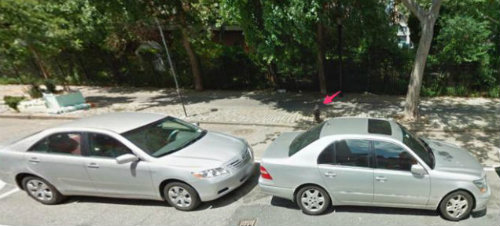NYC fire hydrant earns twice minumum wage
The dome-headed, knee-height object looks like an average fire hydrant, but the water gusher on Forsyth Street in New York City’s Lower East Side is netting the city extraordinary gains: $33,118 annually, Ben Wellington estimates. The statistics professor from Pratt Institute, studying figures from NYC Open Data, suspected something was amiss when one address repeatedly turned up parking tickets.
For comparison, a worker putting in 40 hours per week at NYC’s minimum wage of $8.00 per hour will earn $16,640 in a year – almost exactly half the hydrant’s annual take.

The 2014 U.S. poverty line for a single-person household in the lower 48 states: $11,670. In much of the country, this fire hydrant’s annual income of $33,118 plants it in the middle class. From Gizmodo.
Across from 152 Forsyth Street, a fire hydrant had caused 187 drivers in a seven-month period to receive tickets. It’s set about seven feet back from the road, but cars aren’t allowed to park within fifteen feet of hydrants. Motorists often park at the location, however, because of misleading white lines painted on the street.
The space between the lines is wide enough for a car, and in some areas, it’s marked by diagonal lines—but not in front of the hydrant, suggesting that the space is reserved for parking. The problem is compounded by a sidewalk extension that was constructed in 2008 to provide more room for pedestrians strolling along the east side of Sara D. Roosevelt Park.
Unfortunately, the extension is separated from the original curb by raised cobblestones landscaped with trees. Many believe that that area delineates the sidewalk and that the space between it and the markings is a bike lane. Indeed, according to the New York Post, many cyclists use it as such. And the city’s Department of Transportation (DOT) has said that drivers may park in front of hydrants if a protected bike lane separates vehicles from them.
In a Twitter exchange with journalist Alex Silverman last fall, the agency approved the practice “if there is a designated marked parking space and the pertinent parking sign authorizes parking.” No parking sign authorizes parking at that spot, but the DOT has said that it will review the street markings that are contributing to the problem.
Until then, unsuspecting drivers may continue to receive tickets, which, at $115 a pop, earned the city $21,505 in the seven-month period studied by Wellington. That doesn’t sit well with Sharon Hoahing, who works near the controversial hydrant.
“It’s unbelievable how often the cops come by here,” she told the Post. “I have no problem with them saying, ‘You can’t park there.’ If it’s a hydrant, mark it off correctly.” For Steven Harvey, who received a citation, the problem doesn’t reside with the markings, but with the hydrant itself. “I had no idea it was a hydrant,” he said. “It was set so far back.”
Related Posts
Category: Miscellaneous, No Parking

















